Landing operation in the gulf of Suvla
4 June 1915, the allied command organized a new attack on Critia. This time the artillery preparation was insignificant. The ground forces supported the entire 4 battleship with the assistance of several destroyers. The Allies feared the German submarines.
In 11 hour. 20 min. 24 Thousands of soldiers rushed to the attack on the site just 5 kilometers. In total, on this day, the British threw 30 thousand soldiers into battle, and the French 1 ½ division. As during the previous attacks, at the beginning of the Allied forces had some progress, especially the French distinguished themselves. However, then the Allies came upon a strong defense, and the Turks launched a counteroffensive. The German-Turkish command was able to successfully use field artillery and, thanks to a developed system of field fortifications, quickly and imperceptibly brought their reinforcements to the line of fire, which gave them a numerical advantage. The allies had to throw into the battle all the reserves in order not to suffer defeat.
By the end of the day, as a result of the 9 th and 12 th Turkish divisions, the Allied forces rolled back. As a result, the Allies were able to advance at different sites on 200-400 meters during the day of the bloody battle, taking places at the leading edge of the Turkish positions. For this "success" the allies paid a heavy price: the British lost 5 thousand people, the French lost 2 thousand people. The total number of losses suffered by the allies since the beginning of the operation reached 50 thousand people.
On the night of June 5, Turkish troops, hoping for the drop in the combat capability of the enemy troops, attacked the French positions. However, all Turkish attacks were repulsed with heavy losses for the Ottomans. The German-Turkish command had to replace part of the troops, exsanguinated by the fighting, with fresh units from the 2 of the Turkish army, Vehiba Pasha.
After this a considerable period of time there were no major battles. During June and almost all of July, battles of purely local importance continued on Gallipoli, when both sides could move forward or backward only a few meters. It was only at the end of June that the French finally took and consolidated the strong fortifications of the “Turkish Bob” with a strong blow by parts of the Foreign Legion and the Zouavas. At the same time, the British took the Boomerang redoubt. The French command in these battles lost its leadership. General Gouraud was wounded, and the commander of the 1 of the French division, Masnou, was mortally wounded. French troops led by the commander of the 2 of the French division, General Bell. The Turks under the personal command of Enver Pasha at the end of June again tried to dump the Australian-New Zealand Corps into the sea. The attack was repelled with heavy losses for the Turks.
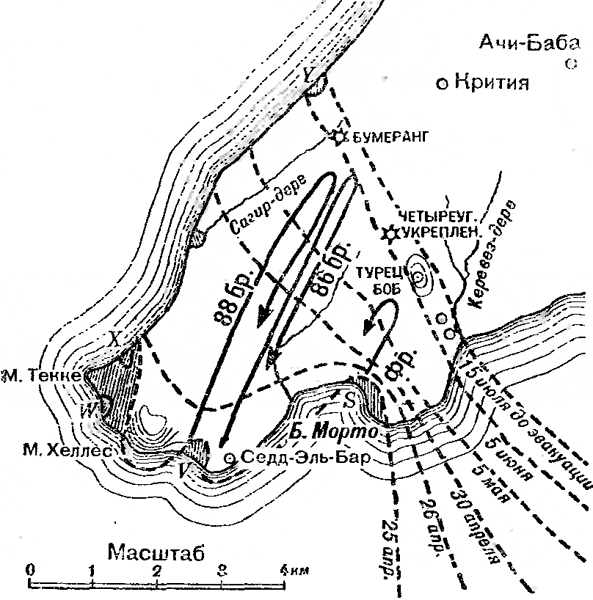
Promotion of British troops. Source: Kolenkovsky A.K. Dardanelles operation
Results of the first stage of the battle
Thus, the confrontation finally developed into a positional war. Both sides were buried in the ground, as on the French front. The Allies did not succeed due to the constant loss of time, delayed with the development of the operation. At first they tried to act only fleet, without ground forces; then they did not create a sufficient advantage of forces and means for the first powerful strike; when they began to throw strong reinforcements, the Turks had already created a strong defense and formed large reserves. As a result, it came to the point that the fleet, which always supported the ground forces, was compelled, for fear of submarines, to anchor in the protected Mudros Bay. The main reason for the failure of the allied offensive was the poor organization of the operation by the high command. The Allies underestimated the enemy, constantly wasted time, and when they increased their efforts, the enemy was already ready for such a turn of events.
The German-Turkish command well used the time factor to create a strong defense and the formation of large reserves. However, the lack of artillery (24 guns per division), especially heavy and ammunition, as well as other technical means, did not allow the Ottomans to dump their allies into the sea. The Turks could not organize a powerful artillery training and break through the dense defensive orders of the Anglo-French troops. They also could not bypass the enemy, whose flanks rested against the sea. As a result, the German-Turkish command organized night attacks, which, in conditions of high density of the Allied forces’s gun, machine gun and artillery fire, led to huge losses for the Turkish troops. Only the transfer of fresh divisions from Thrace allowed the Ottomans to maintain the combat capability of the army. As a result, the main problem of the Turkish army was the material backwardness.
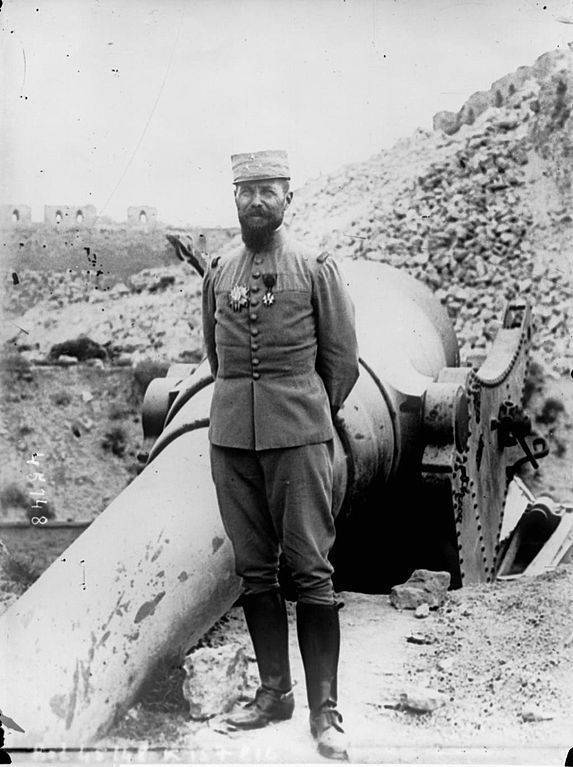
Commander of the French Dardanelles Expeditionary Force Henri Joseph Eugene Gourette
Preparing a new offensive
Supreme Allied Command decided to continue the operation. The 52 Infantry Division was sent to Hamilton. In addition, Britain and France now very much hoped for the support of the Russians that Russia would land large forces on the Black Sea coast of European Turkey. However, this hope did not materialize. March 28 The Rostislav and Three Saints battleships fired at Turkish coastal batteries of the Bosphorus, firing more than a hundred shells. Later, the Black Sea Fleet several times organized such raids. But it was a demonstration of power that could not change the situation in favor of the Allies in the area of the straits.
Apparently, the Russian government was not eager to help the Anglo-French troops in the breakthrough to Constantinople. A brief seizure of Constantinople could help Russia, would weaken Turkey, perhaps, brought it out of the war, would lead to the discovery of important communication between the Entente powers. However, in the long term, this success of England and France would have damaged Russian military-strategic interests, since the British and French would not leave Constantinople, leaving him Russian.
Russia was preparing the landing corps. However, the German offensive, which began in May 1915, finally put an end to the idea of a landing force in the Bosphorus. The “Great Retreat” of the Russian army began, and the Stavka had to search for all free reserves in order to keep the strategic front. As a result, the Anglo-French troops were supported only by a small assault team from the Russian cruiser Askold.
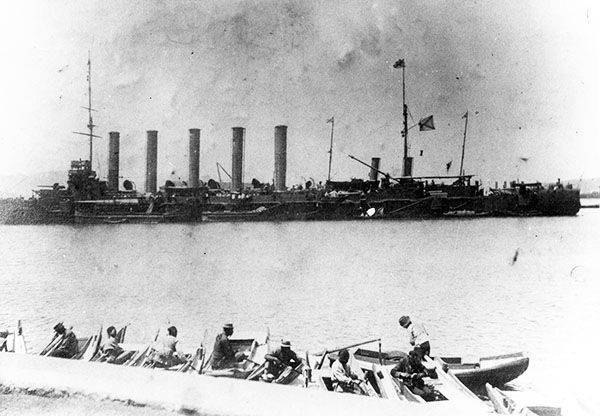
Armored Cruiser "Askold"
Italy 24 May 1915 acted on the side of the Entente, bargaining for significant concessions from England, France and Russia (mainly at the expense of Austria). However, Italy declined to participate in the Dardanelles operation. Greece and Bulgaria still preferred to remain neutral. In Greece, the Germanophile party temporarily prevailed. The Greeks were more interested in the threat from Bulgaria and offered to organize an operation against Bulgaria. The Anglo-French command, in order to avoid a conflict with Bulgaria, rejected this unexpected proposal. Bulgaria continued to maintain a "wise neutrality", continuing to bargain with the Entente, and with Germany.
Meanwhile, Hamilton demanded reinforcements, pointing out that two divisions were few, at least two army corps were needed to change the situation in favor of the expeditionary army. However, for a long time his requests remained unanswered. Only in June, 1915 considered them and decided to give Hamilton five fresh divisions, of which three just formed were to arrive by mid-July, and two territorial divisions were ordered to transfer to Alexandria and the island of Malta as a reserve of troops operating on Gallipoli the peninsula. As a result, the number of British divisions under the command of Hamilton was brought to 10, including reserves, not counting the French divisions 2.
In addition, the maritime component of the expeditionary forces decided to strengthen the monitors with heavy guns and old cruisers with attached antimine mine. Ships began to arrive from mid-July. By the end of the month, 5 monitors and 4 adapted cruisers arrived, these ships had a significant advantage in shelling the coast.
Hamilton developed a new plan of operation. According to a thought prompted by the ANZAC commander Birdwood, commander of the Australian-New Zealand Corps, the Allies were to take the Sari-Bair hill, which dominated the left flank of the Australian troops, and a narrow part of the Gallipoli peninsula, cutting off all communications of the Turks to the southern part of the peninsula. To do this, they decided to land a landing in the bay of Suvla with simultaneous demonstrations north of the Gulf of Saros and on the Asian coast against Mytilene. It was believed that these operations will draw a part of the Turkish troops from the peninsula. Preliminary reconnaissance revealed that Suvla was poorly defended by Turkish troops.
In early August 1915, the operation was ready. In addition to the available 3-Army Corps, ANZAC and two French divisions Hamilton received: 13-Infantry Division, who had arrived on the peninsula in July, 9-Army Corps Frederick Stopford as part 10-rd and 11-th Infantry Division, which was transferred to the Lemnos, 53 and 54 infantry divisions, arrived in early August. As a result, the Allied army grouping was significantly strengthened - up to 157 thousand people, including 30 thousand French.
The number of all parts was brought to the regular, the material part replenished. The Allied fleet was ready for operation. The Allied Command hoped that this time a strong army, relying on a powerful fleet and equipped with everything necessary, would achieve decisive success.
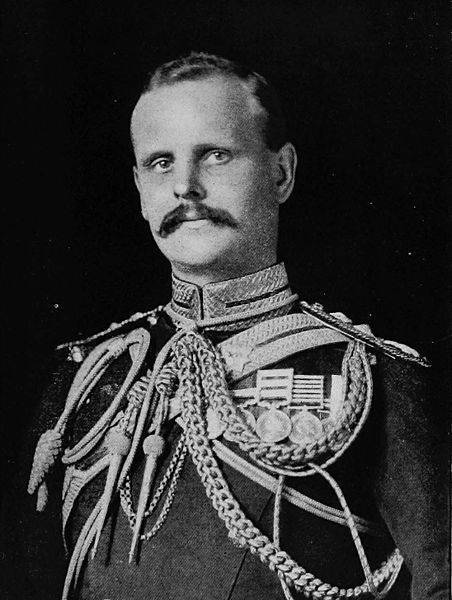
Commander of the Australian-New Zealand Army Corps, William Riddel Bidwood
Field Marshal Lord Kitchener and General William Bidwood in positions during the Battle of Gallipoli
Plan of operation Forces of the parties
The British command decided to widely use the principle of surprise. The troops were to leave their bases at night, but at night they had to land on a little-explored part of the coast. Due to the threat from enemy submarines, it was decided to abandon the advance shipboard artillery preparation, hoping for surprise.
Hamilton planned to cover the right flank of the Turkish army (the Essad Pasha group), which occupied the area from Ari-Bourne to the southern extremity of Suvla bay. In order to distract the enemy’s attention, they decided to conduct distracting operations on the section between Helles metro station and Ari-Bournou, on the plot plot of Helles and in the Gulf of Saros. Meanwhile, the ANZAC was supposed to strike at 4 km south of Suvla, and the 9 corps was to land in the bay of Suvla. The combined efforts of the ANZAC and IX Corps, that is, the shock group in 65 thousand bayonets, were supposed to discard the advanced parts of the Turks and cover the Essada Pasha group, surrounding the Sari-Bair massif from the north. Then the Allies were to capture Akbash, a port on the Sea of Marmara, in the rear of the 5 Turkish army.
The main strike north of the Australian-New Zealand Corps was to be delivered by the 10-th, 11-i, 53-i and 54-i infantry divisions. The ANZAC was reinforced by the 13 Infantry Division and the 29 Indian Brigade. The British 29 and 42 Infantry Divisions, together with two French divisions, were to attack the enemy on the southern tip of the peninsula in the Kritii area.
The final plan envisaged the landing of the 34 th brigade in the very bay of Suvla, and the 32 th and 33 th brigade - on the Nibrunesi section. After occupying the Lala Baba hill, these units were to develop an offensive to the north. Artillery support was provided by monitors, old cruisers and destroyers. Australian troops were to take the hill of Sari-Bair. General Birdwood reinforced the 13 Infantry Division and the 29 Indian Brigade in addition to the two Australian-New Zealand divisions (five brigades). For the attack in his sector in the main direction, Birdwood singled out 2 / 3 with all its forces, in total 25, in total, thousand bayonets.
The British were wrong about the weakness of the Turkish defense in the area. The Sari-Baira Upland, which dominates Maidos and Nagara, was one of the three main fortified positions on the peninsula at that time. The first fortified strip was the heights of Achi-Baba, the second - the fortified strip of the Sari-Baira hills, and finally, the third strip stretched from Bulair to Gallipoli. The German-Turkish command has long since completed work to strengthen the three defensive lines, and especially took care of the possible strong strengthening of the Sari-Bair and Suvla regions. It was also prepared for the defense of the valley of Anafarta. Strong and well-placed artillery batteries were prepared, which swept the Anafart Plain and the approaches to the hills of Sari-Bair.
Sanders army was seriously strengthened. Divisions, badly damaged in previous battles, were replaced. The forces of 5 Army Sanders were brought to the 15 divisions. In addition, 1-i and 2-i Turkish armies were still stationed in Thrace, ready to give the 5-i army new reinforcements.
The 5 Army occupied two fortified sectors: 1) southern on the front of Helles metro station 6 - 8 km defended 5 infantry divisions: 1-I, 10-i, 13-I and 14-i, having 8-i in reserve infantry division; 2) northern Ari-Burnu front, 6 - 5 km, defended 3 infantry divisions: 16-I and 19-i, having in reserve 5-th infantry division; 3) the remaining six divisions made up a mobile reserve for parrying a possible enemy strike.
Of the free divisions, three divisions were located on the Asian coast: the 2-I and 3-I infantry divisions were in the first echelon, and the 11-i division was in reserve. On the European coast in reserve were located: 9-I infantry division at Kum-Tepe and 2) 4-I division - at Kayal-Tepe. The right flank on the side of the Suvla bay of the Essad Pasha group was provided by a specially formed separate unit of Major Willmer, consisting of 3 battalions, 4 batteries and 1 squadrons (3,5 thousand people). On the Gulf of Saros in the area of Bulair, which caused particular concern to the Turkish command, was the 16 th army corps as part of the 7 th and 12 th infantry divisions. To the north was stationed 6-I infantry division with a cavalry brigade. The Turks have improved the supply routes, have corrected the roads, the transport has been adjusted. The transport was carried out by land by pack transport and the sea.
In this case, the German-Turkish command guessed about the plans of the enemy. Sanders denounced: “General Hamilton essentially has only two bridgeheads - Sedd-el-Bar and Gaba-Tepe. It was quite obvious that he would try to expand them. In order to achieve success at Gaba-Tepe, it can be considered probable that he will try to land in the bay of Suvla and advance to Anafarta. We know that he had considerable reinforcements. ”
Thus, the Turkish army had a good defense, strong reserves and guessed about the plans of the enemy. Therefore, the Allied operation was doomed to defeat.
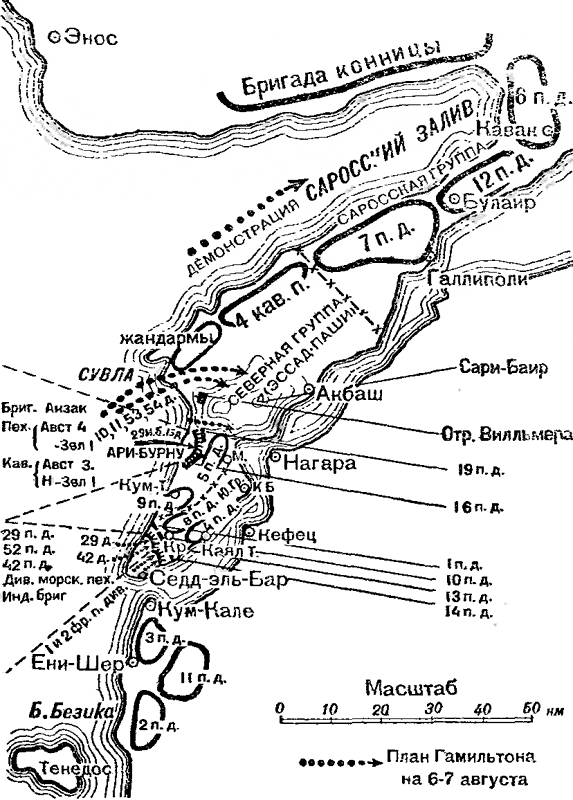
Hamilton's Plan
To be continued ...
- Alexander Samsonov
- 1915 Campaign
Military plans of the Entente and the Central Powers for 1915 year
Death of the 20 Russian Corps
"Rubber War" in the Carpathians
Battle for Prasnysh
Italian "jackal" enters the war
Battle of the Isonzo
Second Battle of the Isonzo
Germany turns east
Bosphorus bait for Russia
Gorlitsky breakthrough
The defeat of the 3 Army Radko-Dmitriev. The death of the 48 "Steel" division of General Kornilov
Departure of Russian armies from Galicia. Loss of Przemysl and Lviv
The great retreat of the Russian army
The fall of Warsaw
Fall of the Newgeorg Fortress
The great retreat of the Russian army was the harbinger of the 1917 disaster of the year.
1915 Campaign of the Year on the Caucasus Front
Solution of the “Christian Question” in Turkey during the First World War
Battle for van
Alashkert operation
Hamadan operation
Sventsian breakthrough
Completion of the 1915 campaign of the year on the Russian front: the battle for Lutsk and Chartoryisk. Operation on the river. Strypa
As England and France set up Russia under the German ram
Dardanelles operation
Dardanelles: defeat at sea
Dardanelles trap
"It was the devil's feast ..." Sturm Gallipoli
Battle of Critia. New losses of the allied fleet
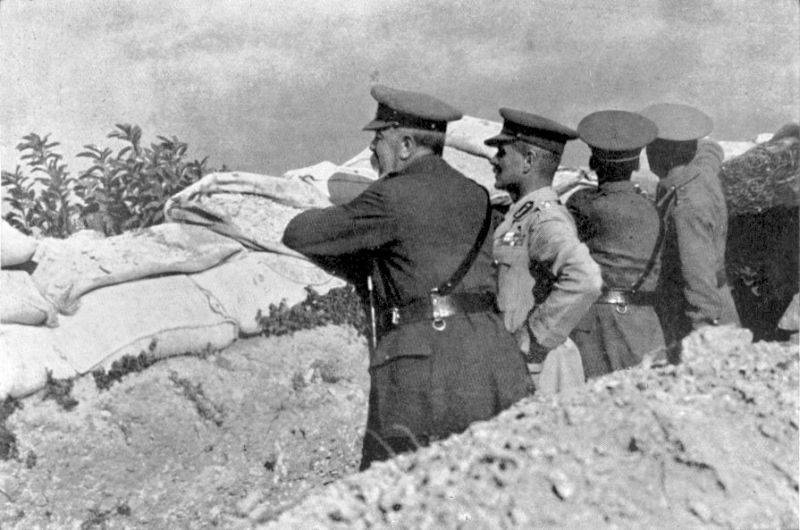
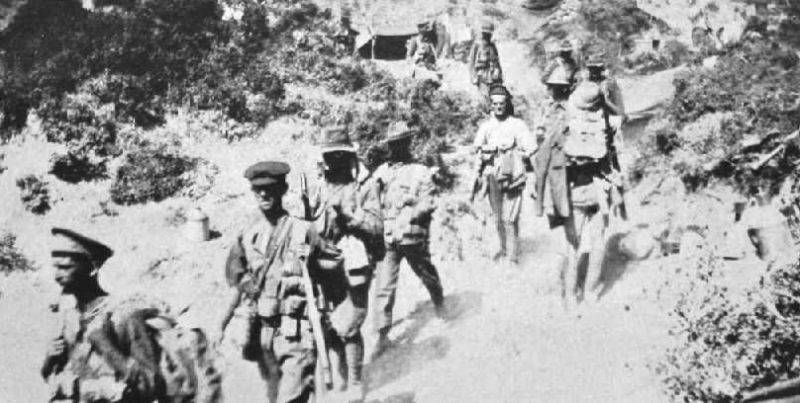
Information